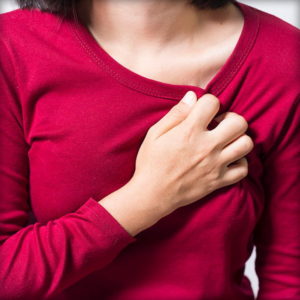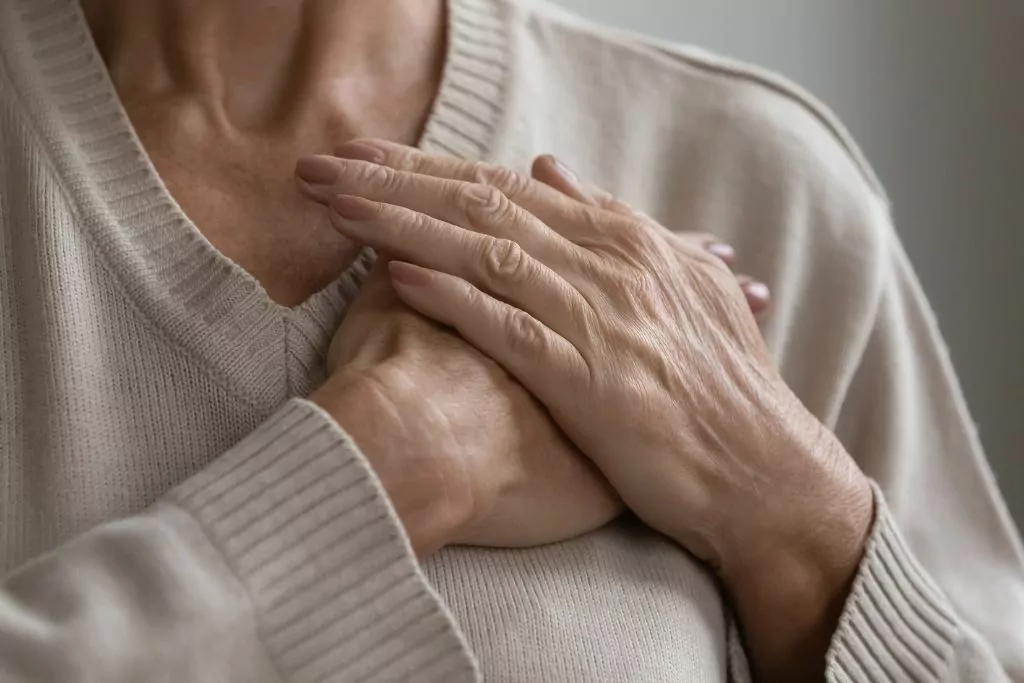Ever felt an unusual tightness in your chest, extreme fatigue, or discomfort in your jaw and thought, maybe I’m just stressed or tired? You’re not alone. Many women experience angina differently than men, which is why it often goes unnoticed. Unlike the classic chest pain we associate with heart problems, angina in women can feel more like indigestion, breathlessness, or even back pain.
So, today let’s break down what angina in women looks like and why you shouldn’t ignore the subtle warnings your body gives you.
Contents
Symptoms of Angina in Women
 Angina doesn’t always feel the same for women as it does for men. Instead of the classic “chest pain” that many associate with heart issues, women often experience more subtle and unusual symptoms. This is why angina in women is frequently misdiagnosed.
Angina doesn’t always feel the same for women as it does for men. Instead of the classic “chest pain” that many associate with heart issues, women often experience more subtle and unusual symptoms. This is why angina in women is frequently misdiagnosed.
Here are the key symptoms women should watch out for:
- Discomfort in the Chest – Unlike the crushing chest pain seen in men, women may feel mild pressure, tightness, or burning that comes and goes.
- Pain in the Neck, Jaw, or Back – Angina in women often shows up as discomfort in the jaw, shoulders, upper back, or even arms, rather than the center of the chest.
- Shortness of Breath – Feeling out of breath even with light activity or at rest, sometimes without chest pain.
- Unusual Fatigue – Feeling extremely tired or weak, even after a full night’s sleep, can be a warning sign of angina.
- Nausea or Dizziness – Some women experience stomach pain, nausea, or lightheadedness, which can be mistaken for digestive issues.
- Sweating Without a Reason – Breaking out in a cold sweat suddenly, even when you’re not overheating or exerting yourself.
Why do These Symptoms Matter?
Because these symptoms don’t always point directly to the heart, women often ignore them or delay seeking help. But angina is a warning sign that your heart isn’t getting enough oxygen, and ignoring it can lead to serious complications.
If you experience these symptoms, especially during physical activity or stress, don’t brush them off. It’s always better to get checked by a doctor and ensure your heart is healthy.
How is Angina in Women Different from Men?
When we think of angina, we often imagine severe chest pain—but for women, it doesn’t always show up that way. Women experience angina differently than men, which can make it harder to recognize and diagnose. Here’s how:
1. Symptoms Are More Subtle in Women
Men typically experience classic chest pain—a heavy, squeezing, or pressure-like sensation in the chest, often triggered by physical activity. Women, on the other hand, may have more subtle symptoms, such as:
- Jaw, neck, shoulder, or back pain
- Unexplained fatigue
- Shortness of breath
- Nausea or dizziness
- Sweating without exertion
Because these symptoms don’t always point directly to the heart, women may mistake them for stress, acid reflux, or anxiety—leading to delayed treatment.
2. Different Causes of Angina
- In men, angina is often caused by blockages in the major coronary arteries (Obstructive Coronary Artery Disease or CAD).
- In women, angina can also be caused by smaller artery dysfunction (Microvascular Angina), where the tiny blood vessels of the heart don’t work properly, restricting blood flow. This condition is harder to detect with standard heart tests.
3. When Angina Occurs
- Men tend to experience angina during physical exertion, like exercising or lifting something heavy.
- Women can have angina even at rest, during emotional stress, or while sleeping. Hormonal fluctuations may also play a role in triggering symptoms.
4. Diagnosis Challenges
Because women’s angina symptoms are different, standard heart tests like ECGs and stress tests may not always detect the problem. Women often need more advanced testing, like stress echocardiograms or coronary microvascular testing, to diagnose the issue correctly.
Why This Matters
Since women’s symptoms don’t always fit the “classic” angina pattern, they are often misdiagnosed or dismissed. Many women delay seeking help, thinking their discomfort is not heart-related. But heart disease is the No. 1 killer of women—so recognizing the unique symptoms is crucial for early diagnosis and prevention.
If you or someone you know experiences unexplained fatigue, shortness of breath, or unusual pain, don’t ignore it. Listen to your heart—it could save your life.
Treatment of Angina in Women
 Treating angina in women isn’t just about relieving pain—it’s about improving heart health and preventing complications. Here’s how angina in women is managed:
Treating angina in women isn’t just about relieving pain—it’s about improving heart health and preventing complications. Here’s how angina in women is managed:
1. Lifestyle Changes: The First Step
Small but consistent lifestyle changes can reduce angina episodes and improve heart health:
- Heart-Healthy Diet – Eat more fruits, vegetables, whole grains, lean proteins (fish, chicken, tofu), and healthy fats (avocados, nuts, olive oil). Avoid processed foods, excess salt, and unhealthy fats.
- Regular Physical Activity – Light to moderate exercise (like walking, swimming, or yoga) helps strengthen the heart. Always check with your doctor about safe exercise levels.
- Stress Management – Since emotional stress can trigger angina, practices like meditation, deep breathing, and mindfulness can help.
- Quit Smoking & Limit Alcohol – Smoking damages blood vessels, increasing angina risk. Cutting back on alcohol also helps keep blood pressure and cholesterol in check.
2. Medications for Angina Relief
Women with angina may be prescribed medications to improve blood flow and reduce heart strain:
- Nitrates (Nitroglycerin) – Helps widen blood vessels to improve blood flow and relieve chest pain.
- Beta-blockers & Calcium Channel Blockers – Reduce heart rate and blood pressure, easing strain on the heart.
- Aspirin or Blood Thinners – Help prevent blood clots that could lead to a heart attack.
- Statins – Lower cholesterol levels and reduce plaque buildup in the arteries.
3. Specialized Treatments for Women
Women are more likely to have Microvascular Angina (caused by dysfunction in small arteries rather than major blockages). In such cases:
- Medications like ACE inhibitors and statins may be used to improve blood vessel function.
- Advanced testing like coronary microvascular function tests may be needed for an accurate diagnosis.
4. Medical Procedures for Severe Cases
If lifestyle changes and medications aren’t enough, medical procedures may be required:
- Angioplasty & Stenting – A small tube (stent) is placed in blocked arteries to keep them open.
- Coronary Artery Bypass Surgery (CABG) – In severe cases, doctors create a new path for blood to bypass blocked arteries.
5. When to See a Doctor
If you frequently experience chest discomfort, shortness of breath, or extreme fatigue, don’t ignore it. Women’s heart symptoms are often dismissed—but early diagnosis and treatment can save lives.
Your heart health matters! If you need expert care, consulting a cardiologist is the best way to manage angina and prevent serious complications.
What Is the Fastest Way to Stop Angina in Women?
When angina strikes, the goal is to quickly relieve chest discomfort and restore proper blood flow to the heart. Here’s what women can do immediately to stop an angina episode:
1. Sit down and stay calm. If angina is triggered by physical activity or stress, stopping what you’re doing and resting can help reduce the heart’s oxygen demand.
2. Take a nitroglycerin tablet or spray under your tongue as directed by your doctor. This medication helps relax and widen blood vessels, improving blood flow to the heart within 1–5 minutes.
3. Slow, deep breaths can help reduce anxiety and lower your heart rate, easing chest discomfort. Try the 4-7-8 breathing technique:
- Inhale for 4 seconds
- Hold for 7 seconds
- Exhale slowly for 8 seconds
4. Chew and swallow a low-dose aspirin (81 mg) if you’re at risk of heart disease and your doctor has recommended it. This helps prevent blood clots that can worsen angina or lead to a heart attack.
5. Drink a small amount of water and avoid overheating, as dehydration can worsen angina symptoms.
6. Seek medical help immediately if:
- The pain lasts longer than 5 minutes despite taking nitroglycerin.
- The pain feels different or more intense than usual.
- You experience shortness of breath, dizziness, nausea, or fainting.
⚠️ Important:
Women’s angina symptoms can be more subtle than men’s. If you feel extreme fatigue, jaw pain, or shortness of breath without chest pain, don’t ignore it—call for medical help right away.
Final Thoughts
Angina in women can show up in unexpected ways, so paying attention to your body’s signals is key. Simple lifestyle changes, the right medications, and early medical intervention can help manage symptoms and prevent serious complications.
If you ever experience persistent chest discomfort, unusual fatigue, or shortness of breath, don’t wait—seek expert help. MantraDoc connects you with experienced cardiologists who can guide you with the right diagnosis and treatment.
Take care of your heart—schedule a consultation with MantraDoc today!

